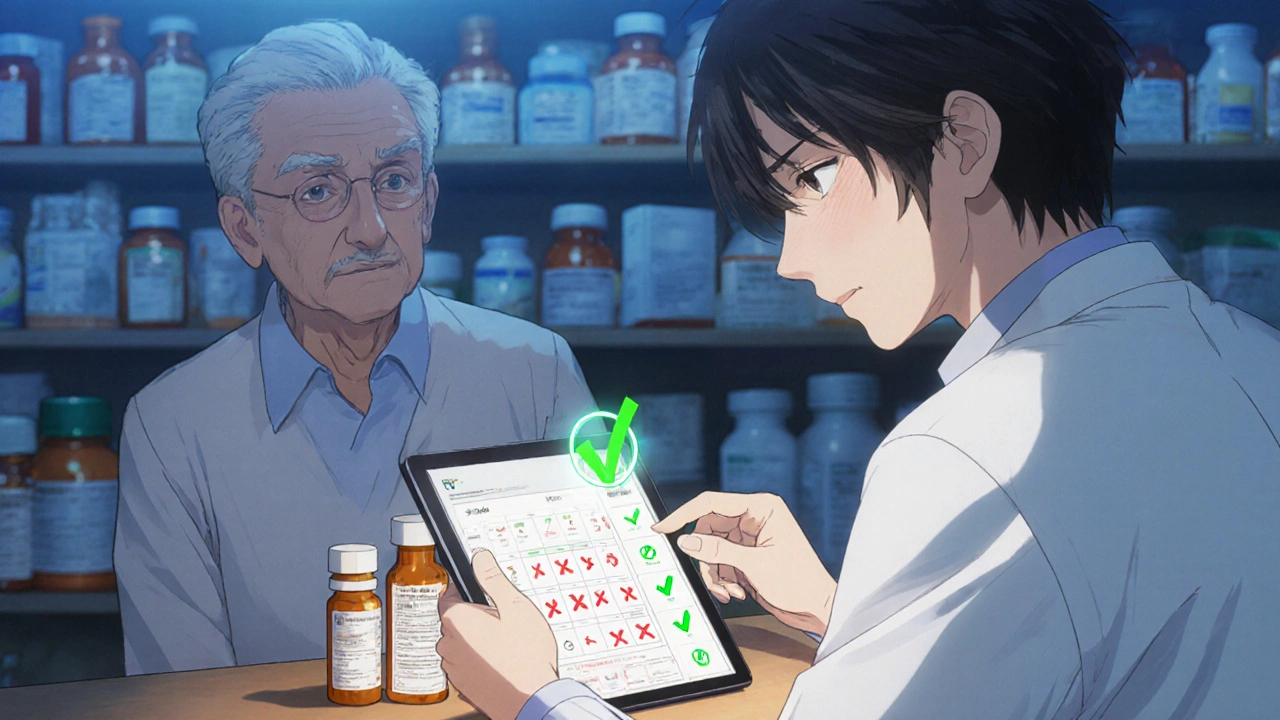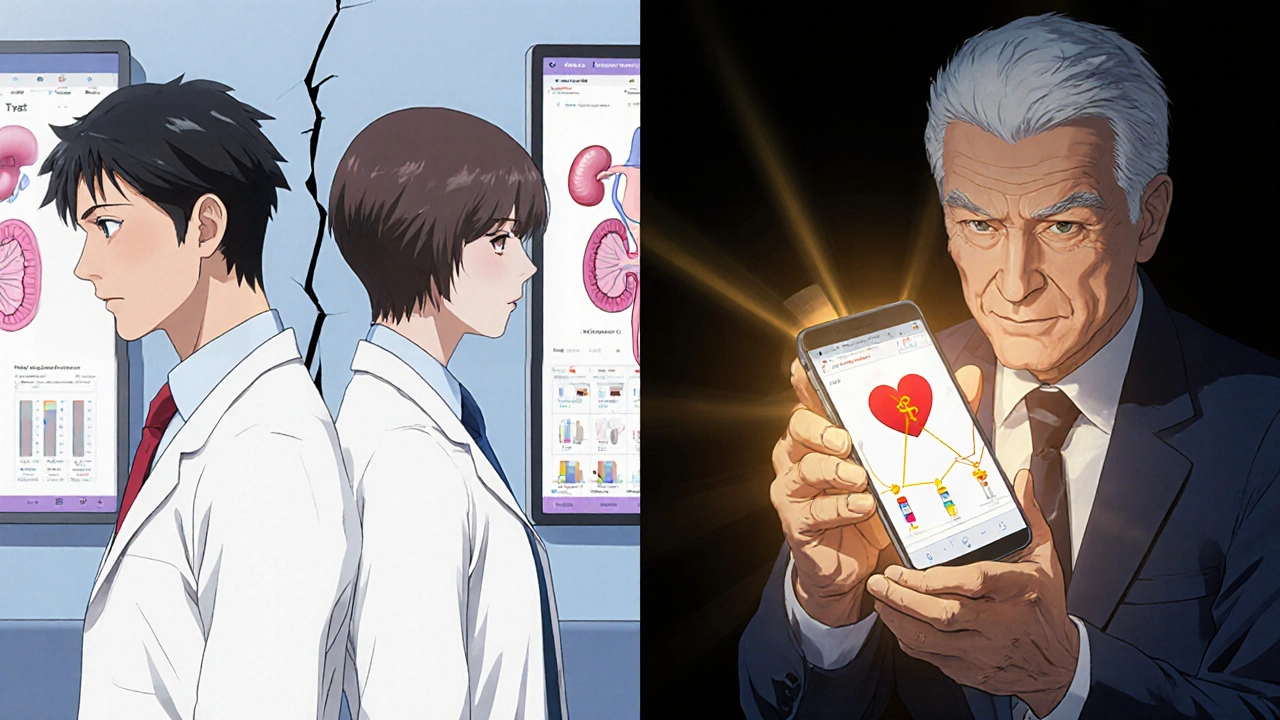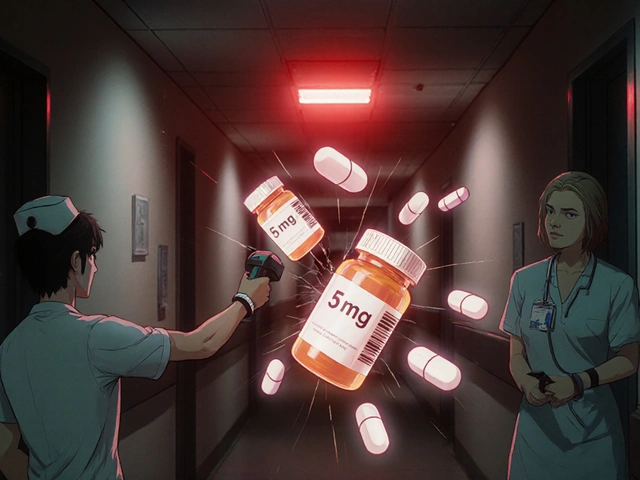
Every year, thousands of seniors end up taking two or more drugs that do the same thing-like two different blood pressure pills or two types of pain relievers from the same family. It’s not because doctors are careless. It’s because specialists often don’t know what other doctors have prescribed. A cardiologist focuses on your heart. A neurologist treats your nerves. Your primary care doctor manages your overall health. But unless someone is looking at the full picture, you could be getting duplicate meds-and that’s dangerous.
Why Duplicate Medications Are a Silent Threat
Think about this: if you’re taking metoprolol for high blood pressure and then see a cardiologist who prescribes another beta-blocker like atenolol, you’re doubling down on the same effect. Your blood pressure could drop too low. You might feel dizzy, faint, or even have a fall. That’s not rare. A 2015 study across 53 community pharmacies found that for every 100 prescriptions filled, about 20 triggered a duplicate medication alert. In nearly one-third of those cases, pharmacists had to step in and fix it. For seniors, the risk is even higher. People over 65 often see multiple specialists and take five, ten, or even more medications. Each new prescription adds another chance for overlap. The National Institutes of Health says medication errors like this are one of the top causes of hospital visits in older adults. And it’s not just prescriptions. Over-the-counter painkillers like ibuprofen or naproxen can also duplicate what’s already in your regimen. Same goes for supplements-some herbal products have hidden effects that mimic prescription drugs.How Duplication Happens (Even When Doctors Mean Well)
Here’s how it usually plays out:- You visit your primary care doctor for high blood pressure. They prescribe lisinopril.
- Three months later, you see a nephrologist for kidney issues. They don’t know about the lisinopril. They prescribe another ACE inhibitor-enalapril.
- You fill both at different pharmacies. Neither pharmacist sees the full list.
- Two weeks later, you feel weak, tired, and your blood pressure is dangerously low.
What You Can Do Right Now to Stop It
You don’t need to wait for your doctor to fix this. You’re the most important person in your own care. Here’s what works:- Keep a living medication list-not just a mental note. Write down every pill, patch, injection, OTC drug, vitamin, and supplement. Include the dose and why you take it. Example: “Lisinopril 10mg daily-for high blood pressure.”
- Bring your actual pill bottles to every appointment. Doctors often ask, “What are you taking?” But they rarely check. When you show the labels, they see the exact name, strength, and manufacturer. No guesswork.
- Use one pharmacy for everything. Chain pharmacies like CVS, Walgreens, or local independents can track all your prescriptions in one system. If a duplicate shows up, their computer flags it before you even walk out the door.
- Ask every specialist: “Is this new medicine replacing something I’m already taking?” Don’t assume they know. Say it plainly: “I’m already on a similar drug. Are we doubling up?”
- Ask your pharmacist to review your full list every time you pick up a new script. Pharmacists are trained to spot duplicates. They just need the full picture.

What Your Doctor Should Be Doing (But Often Isn’t)
Good providers follow a process called medication reconciliation. That means comparing what you’re currently taking with what’s being ordered-every time you switch care settings. That’s at discharge from the hospital. At every specialist visit. Even during routine checkups. The Joint Commission, which sets hospital safety standards, has required this since 2006. But in practice, it’s patchy. Why? Time. Paperwork. Fragmented records. A 2022 survey found that 42% of pharmacists blame poor communication between providers as the main reason for duplication errors. Ask your primary care doctor: “Do you have a full list of all my meds from every specialist?” If they say yes, ask to see it. If they don’t, offer to bring your bottle list and ask them to update it. Better yet, request a formal medication reconciliation during your next visit. It’s your right.Technology Can Help-If You Use It
There are apps now that let you scan your pill bottles and store your meds digitally. Some even sync with pharmacy records. Try MyTherapy, Medisafe, or even Apple Health. Take a photo of each label. Enter the reason you take it. Set reminders. Then, when you go to a new doctor, you can show them your phone. Some clinics, like Kaiser Permanente, have cut duplicate prescriptions by 37% by requiring every new prescription to include the reason it’s being given. So instead of just writing “Metformin 500mg,” the doctor writes “Metformin 500mg-for type 2 diabetes.” That simple change helps pharmacists and other doctors spot overlaps faster. New AI tools are being tested at places like Mayo Clinic. These systems scan your chart and flag hidden duplicates that humans might miss. One pilot program boosted detection rates by over 140%. But until these tools are standard everywhere, you still need to be your own advocate.Real Stories: What Happens When No One Checks
One woman in Ohio was taking warfarin for a blood clot. Her cardiologist added aspirin for “heart protection” without knowing she was already on blood thinners. She ended up in the ER with internal bleeding. Another man in Florida was on two different statins-simvastatin and atorvastatin-for cholesterol. He didn’t know they did the same thing. His muscles started to break down. He needed hospitalization. These aren’t outliers. They’re common. And they’re preventable.
When to Say No-And How
Sometimes, a specialist prescribes something new because they think it’s better. But maybe it’s not needed. You have the right to ask:- “Is this medicine really necessary?”
- “Can we try stopping one of the others first?”
- “Are we treating the same problem with two drugs?”
Final Checklist: Your Daily Protection Plan
Make this part of your routine:- Update your medication list every time you get a new prescription or stop one.
- Carry your list and pill bottles to every appointment-specialist or not.
- Use one pharmacy. Always.
- Ask your pharmacist: “Can you check for duplicates?”
- Ask every doctor: “Is this replacing something I’m already taking?”
- Use a digital app to track everything. Even a simple Notes app works.
Bottom Line: You’re the Key
No system is perfect. Doctors are busy. Pharmacies are overwhelmed. Technology helps-but it doesn’t replace you. The truth is, you’re the only person who knows exactly what’s in your medicine cabinet. You’re the only one who can connect the dots between your cardiologist, your endocrinologist, and your primary care doctor. Take 10 minutes this week to write down every medication you take. Bring it to your next visit. Ask the questions. Don’t wait for someone else to catch the mistake. You’re the best safety net you’ve got.How do I know if I’m taking duplicate medications?
Look for drugs with the same generic name or from the same class-like two different ACE inhibitors (lisinopril and enalapril), two statins (atorvastatin and simvastatin), or two NSAIDs (ibuprofen and naproxen). If you’re taking two drugs for the same condition (like high blood pressure or cholesterol) and your doctor didn’t say to switch, that’s a red flag. Use a medication app or bring your pill bottles to your pharmacist-they can spot these quickly.
Can over-the-counter drugs cause duplicate therapy?
Absolutely. Many OTC pain relievers like ibuprofen, naproxen, or aspirin are NSAIDs and can overlap with prescription versions. Some cold medicines contain acetaminophen, which can add up if you’re also taking Tylenol. Even supplements like St. John’s Wort can interact with antidepressants or blood thinners. Always include OTCs and supplements on your list-don’t assume they’re harmless.
Why do specialists prescribe duplicates without knowing?
Specialists often don’t have full access to your medical records, especially if you see doctors outside their health system. Electronic health records don’t always talk to each other. Even when they do, alerts can be turned off or ignored if they’re too frequent. Plus, specialists focus on one organ or condition and may not realize another doctor already treated it with a similar drug.
Should I stop a duplicate medication myself?
Never stop a medication without talking to your doctor first. Stopping suddenly can be dangerous-especially for blood pressure, heart, or mental health drugs. Instead, bring your list to your primary care provider and ask them to review all your meds together. They can safely adjust what’s needed.
How often should I update my medication list?
Update it every time you start, stop, or change the dose of any medication-even if it’s just for a few days. Also update it after every specialist visit, hospital stay, or pharmacy refill. Keep the list in your wallet, on your phone, and share a copy with a trusted family member.
What if my doctor says the duplicate is intentional?
Ask for the reason. Sometimes, doctors combine drugs for better control-like a low-dose diuretic with a blood pressure pill. But they should explain why. If they say, “It’s just how we do it,” ask for evidence. Request a written explanation or a second opinion. You have the right to understand every medication you take.




Matthew Peters
November 20, 2025Man I had no idea this was so common. My grandma took three different blood pressure meds for months until her pharmacist finally caught it. She ended up in the ER dizzy as hell. Now she brings her pill bottles to every appointment like a pro. Smart move.
Doctors are good people but they’re drowning in paperwork. You gotta be your own watchdog.
Liam Strachan
November 20, 2025This is such an important post. I’ve seen this happen with my dad - two different doctors prescribed him two different NSAIDs without realizing it. He ended up with stomach bleeding. It’s terrifying how easily this slips through the cracks.
I’ve started using Medisafe now and it’s been a game changer. Simple, clean, no fuss. Highly recommend.
Gerald Cheruiyot
November 22, 2025Systems fail because humans are fragmented. Specialists are trained to solve one puzzle. But the body isn’t a puzzle. It’s a symphony. And when you stack instruments without listening to the whole piece you get noise not music.
Pharmacists are the unsung conductors. We need them in every room not just behind the counter.
And yes your pills are not just pills. They’re history. They’re intent. They’re your story written in chemical form.
Michael Fessler
November 22, 2025Medication reconciliation is a cornerstone of safe polypharmacy management but implementation is abysmal due to EHR interoperability gaps and lack of standardized protocols across care settings. Most primary care providers don’t have the bandwidth to conduct formal med recs without CPOE integration and clinical decision support that actually reduces alert fatigue.
Pro tip: Use the Beers Criteria to screen for potentially inappropriate meds in seniors. Also flag any OTC NSAIDs or anticholinergics - those are silent killers in elderly populations.
daniel lopez
November 24, 2025They don’t want you to know this but Big Pharma pushes duplicate prescriptions. Why? More pills = more profit. That’s why alerts are turned off. That’s why your records don’t talk. That’s why your doctor doesn’t ask. They’re paid to prescribe not to prevent.
Check your pills. Check your doctors. Check your pharmacy. If they’re not scared of you asking questions they’re not doing their job.
And yes I’ve seen the data. I’ve read the studies. This isn’t an accident. It’s corporate malpractice wrapped in a white coat.
Katie Magnus
November 25, 2025Ugh I’m so tired of this. Like why is it always the patient’s job to fix the system? My aunt died because someone didn’t check her meds. Now I have to carry a binder of pills to every appointment like I’m a damn lab rat.
It’s not fair. It’s not right. And no one in power cares until it’s their mom or their dad.
King Over
November 27, 2025Just bring your bottles. That’s it. No app needed. No checklist. No drama. Just the bottles. Doctors see them. They shut up. Problem solved.
Also use one pharmacy. Always. That’s the easiest win.
Johannah Lavin
November 29, 2025This made me cry. My mom had a stroke last year because two blood thinners were stacked. She’s okay now but her memory is gone in places. I wish I’d known then what I know now.
Thank you for writing this. I’m printing it out and giving it to every senior I know. You’re helping people. Really.
And yes I’m using MyTherapy now. It’s cute. It sends me little hearts when I take my meds. Feels like someone’s watching out for me.
Ravinder Singh
November 30, 2025As a caregiver in India I’ve seen this exact scenario play out with elderly patients - multiple specialists, no central record, family members too overwhelmed to track. We started a simple WhatsApp group where we photograph every new prescription and tag the doctor’s name. It’s low tech but it works.
Also, never underestimate the power of asking ‘Is this replacing something?’ - it forces the doctor to pause and think. Most times they realize they didn’t even check.
You are the bridge. Be the bridge. 🙏